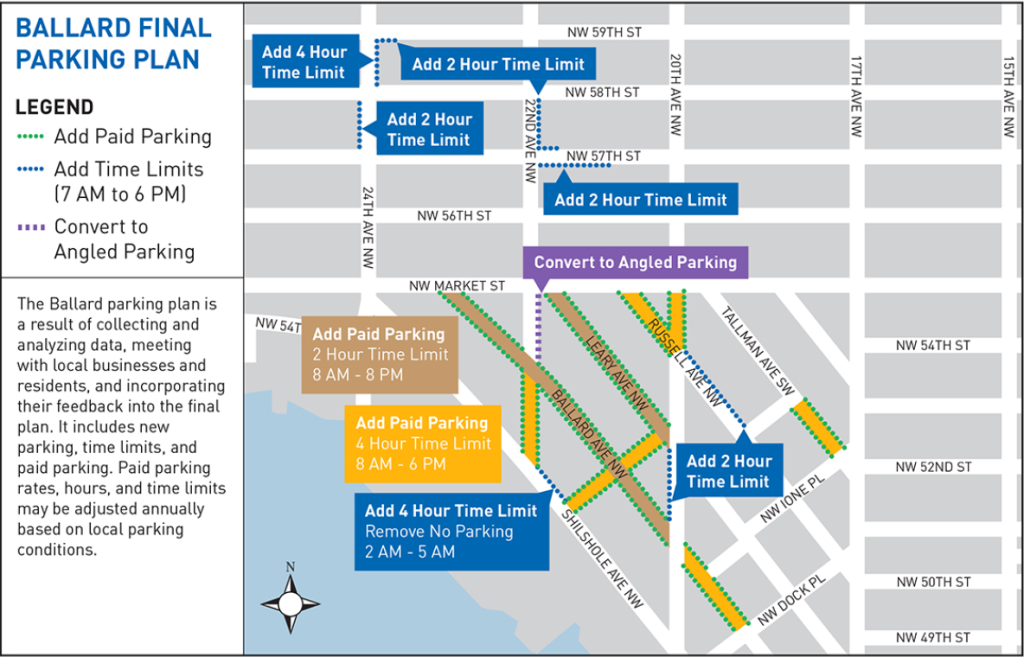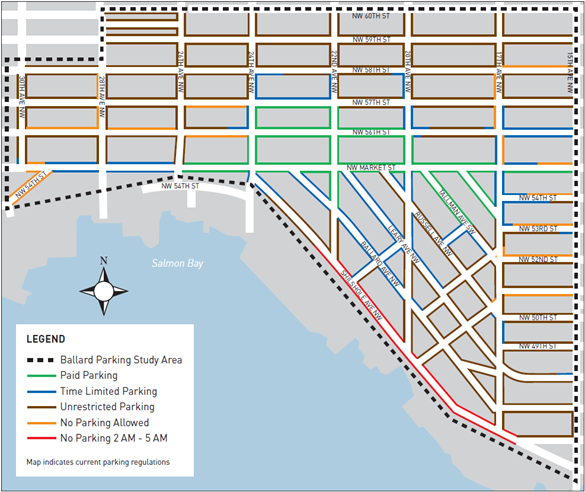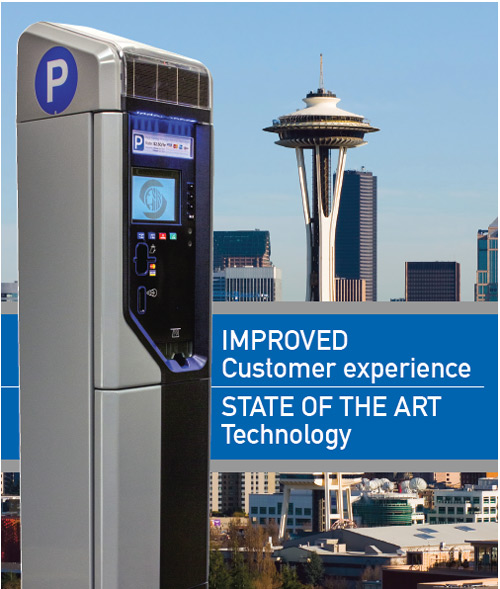
If you’ve ever visited the core of Ballard by car, you’ve probably witnessed the neighborhood’s parking challenges firsthand. Ballard is a highly sought-after neighborhood because of its excellent offerings in nightlife entertainment, restaurants, and boutique shopping. For locals, it’s also a place of daily business, community services, worship, and home. All of these activities combine to create very high demand in a small space, and that often leads to a shortage of parking. However, the Seattle Department of Transportation (SDOT) has a partial solution to this by directly managing parking demand through revised parking restrictions.
Parking restrictions are not new to Ballard (see image below). Most streets in Central Ballard already have some form of restriction, like time limits or paid parking. SDOT most recently modified Ballard parking regulations in September through rate changes. Ballard data from SDOT showed that parking utilization in 2014 was 109% in the Core Area and 58% in Edge Area. In response to these data points, SDOT decreased the hourly parking rate of the Edge Area to $1.00, while increasing rates to $2.00 in the Core Area.

On the new round parking changes, SDOT has this to say:
Despite all of the development and changes in the neighborhood, parking regulations in Ballard have not changed substantially since 2005. The changes for Ballard are geared towards making parking more available and predictable [sic] areas proposed for parking changes are over 90% full for more than three continuous hours of the day, which means drivers often find themselves circling in search of parking.
In addition to our on-street parking studies in Ballard, we also documented off-street parking in a May 2014 study. From this study, we worked with the Ballard Chamber to develop a map that shows the location and hours of over 1,000 public off-street parking spaces available in Ballard today.
As we prepare for the new parking controls, you’ll likely see SDOT out making measurements. Other information about how these changes will be implemented will be regularly updated on the project website. We also received a request for a study to determine eligibility for a restricted parking zone (RPZ) on residential blocks in the neighborhood. We’ll conduct this study in 2015.
For the parking changes slated for Central Ballard, SDOT is focusing efforts on new parking time limits, angled parking, and expansion of paid parking. Time limits will drastically change on many streets, with some having them instituted for the first time. Angled parking will be deployed on the east side of 22nd Avenue NW. And, south of Market Street will see the introduction of paid parking.
For some local merchants, the latter issue has been somewhat controversial. The Noble Fir famously began a petition effort in September to directly oppose an expansion of paid parking along Ballard Avenue. The reason behind the effort was a fear that paid parking would mean fewer customers. However, the data shows that such fears are unfounded, and that paid parking will likely increase sales (similar to how bike lanes increase sales when parking is taken away).
Focusing in on Ballard Avenue, the street allows up to 10 hours of unrestricted parking at no cost to drivers. Yet parking utilization on the street manages to regularly exceed parking capacity by more than 10% on some blocks, making it just as overutilized as Market Street. Under SDOT’s new plan, the street would have a 2-hour maximum parking time limit from 8am to 8pm for most of its length. Paid parking would also be in force during these hours, though rates have yet to be finalized.
And, while this is welcome news, it is worth pointing out that paid parking is only now happening on these streets. This area is perhaps the most active of Ballard, and so it is somewhat puzzling that streets north of Market Street had paid parking before the core activity center south of Market Street.
Regardless of any concerns over paid parking, this parking management technique has been highly successful for Ballard where it has been implemented based upon market demand. Paid parking has led to ample parking space availability in the Edge Area. And despite high parking utilization rates in the Core Area, the revised rates from September should increase parking availability to more reasonable levels in the next study period. New locations for paid parking should also see the same positive outcomes of increased parking availability.
New Pay Parking Stations
 On a related note, SDOT will soon be deploying new parking stations across Seattle. The new parking pay stations are even more high-tech than the last. The reliability of the pay stations should go up with faster processing times for credit cards, fewer instances of timing out, and direct communication with SDOT’s backend management system. The pay stations will include new credit card technology slated to come online (like chip-and-pin), while also being “future proofed” by the vendor for any unforeseen payment technology changes on the horizon.
On a related note, SDOT will soon be deploying new parking stations across Seattle. The new parking pay stations are even more high-tech than the last. The reliability of the pay stations should go up with faster processing times for credit cards, fewer instances of timing out, and direct communication with SDOT’s backend management system. The pay stations will include new credit card technology slated to come online (like chip-and-pin), while also being “future proofed” by the vendor for any unforeseen payment technology changes on the horizon.
A noteworthy feature of the pay stations is the capability of dynamic pricing. The new pay stations can change price based upon the time of day and parking demand. While this feature will not be initially used, it is something that could be on the way in the next few years. SDOT anticipates that 1,500 parking pay stations in total will be replaced between 2015 and 2016. You’ll see these deployed where parking pay stations were originally installed between 2004 and 2010, with the first batch coming to Pioneer Square.
Stephen is a professional urban planner in Puget Sound with a passion for sustainable, livable, and diverse cities. He is especially interested in how policies, regulations, and programs can promote positive outcomes for communities. With stints in great cities like Bellingham and Cork, Stephen currently lives in Seattle. He primarily covers land use and transportation issues and has been with The Urbanist since 2014.


